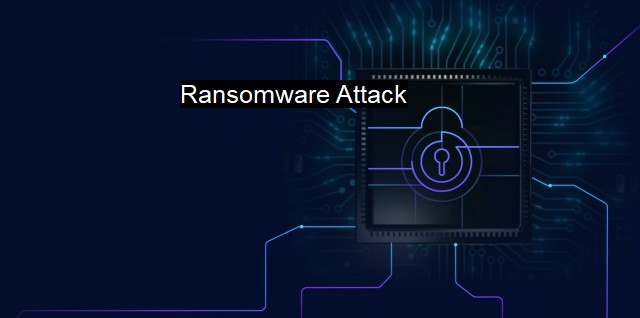What is Ransomware Attack?
The Rise of Ransomware: Understanding the Threat and Staying Secure in the Digital Age.
Ransomware attack is a growing cyber threat and a severe menace to individuals, multinational organizations, local governments and institutions. These attacks pose substantial disruption and financial loss, enhancing the need for robust cybersecurity measures and effective anti-virus defenses.To understand ransomware attacks, one should first comprehend what ransomware entails. Ransomware is a type of malicious software (malware) that cybercriminals use to coerce money from the victims. It works by encrypting the victim's data, rendering it inaccessible until the demanded ransom is paid, typically through an untraceable online payment system, usually in the form of cryptocurrencies like Bitcoin. The aggressor provides the decryption key upon payment. there's no assurance that victims who pay the ransom will recover their data.
There are two primary types of ransomware attacks. In a locker ransomware attack, victims find their computers entirely locked with a ransom message displayed on the screen, denying access to all applications and files. In Crypto Ransomware attacks, the ransomware solely encrypts target files on data management systems, databases, or cloud storage leaving the computing system partially usable.
The mechanism behind a successful ransomware attack primarily involves a victim unwittingly installing the malware on his/her computer. This installation may occur through phishing emails, malicious advertising, or on compromised websites through a method known as "drive-by downloading." misuse of social engineering techniques such as convincing users to click on a link or download an attachment further galvanizes the impact of ransomware attacks.
There has been a sharp increase in ransomware attacks globally due to the economic incentives for criminals. Ransom payment often results in a profitable business model, with victims eager to regain access to their data. the darknet has enabled cybercriminals to trade increasingly sophisticated ransomware and making law enforcement more challenging.
In an era where data is a valuable commodity, ransomware attacks are a significant concern for any organization, big or small. For a business, a ransomware attack could lead to significant downtime, financial loss, potential permanent loss of sensitive data, and reputational damage. In healthcare institutions, ransomware attacks could disrupt patient care and compromise patient data and privacy.
Effective cybersecurity measures are critical in preventing ransomware attacks. Keeping all software and operating systems up-to-date, regular data backups, cybersecurity awareness training, and implementing reliable network security solutions, including powerful firewalls, play a crucial role in mitigating these cyber threats.
Equally important in protecting against ransomware attacks is the use of reliable anti-virus software. Anti-virus software with real-time protection and regular updates can automatically detect, isolate, and remove diverse malware threats, including ransomware, based on defined suspicious activities and malicious code signatures. Regularly scheduled scans are also vital to identify and eliminate any potential threats.
Another tool growing in prominence in the fight against ransomware is artificial intelligence (AI) and machine learning. These technological advancements heighten predictive capabilities, allowing software to detect and neutralize threats based on behavioral analytics even before full encryption commences.
Organizations can create a solid incident response plan to ensure employees know what actions to take if a ransomware attack does occur. This plan usually includes isolating infected devices, removing the ransomware, restoring the data, and analyzing the attack to prevent future incidents.
Despite the increasing cyber threats and growing sophistication of ransomware attacks, precautions such as robust cybersecurity measures, utilizing effective antivirus defenses, staff training, and proactive threat monitoring can significantly reduce the risks associated. Therefore, genuine awareness and understanding of how these threats work are the first steps towards mitigating the risks associated with ransomware attacks.

Ransomware Attack FAQs
What is a ransomware attack?
A ransomware attack is a type of cyberattack where hackers encrypt your files and demand payment in exchange for the decryption key. The ransom is typically paid in cryptocurrency to prevent the attackers from being traced.How do ransomware attacks happen?
Ransomware attacks can happen through several methods, including phishing emails, malicious downloads, or exploiting vulnerabilities in software. Once the attacker gains access to your system, they can install the ransomware and begin encrypting your files.Can antivirus software prevent ransomware attacks?
Antivirus software can help prevent ransomware attacks by detecting and removing malicious software before it does any damage. However, it's crucial to keep your antivirus software up to date and to use caution when downloading files or clicking links, as some ransomware attacks can evade detection.What should I do if I become a victim of a ransomware attack?
If you become a victim of a ransomware attack, it's essential not to pay the ransom. There's no guarantee that the attackers will provide you with the decryption key even if you pay. Instead, you should seek the help of cybersecurity experts who can attempt to recover your files or restore them from backups. You should also report the attack to law enforcement to help prevent future attacks.| | A | | | B | | | C | | | D | | | E | | | F | | | G | | | H | | | I | | | J | | | K | | | L | | | M | |
| | N | | | O | | | P | | | Q | | | R | | | S | | | T | | | U | | | V | | | W | | | X | | | Y | | | Z | |
| | 1 | | | 2 | | | 3 | | | 4 | | | 7 | | | 8 | | |||||||